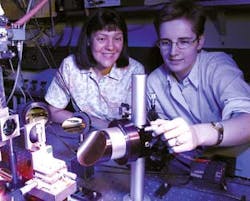
Quantum cascade (QC) lasers have recently gained ground in the commercial world with the licensing of the technology by Applied Optoelectronics Inc. (AOI; Sugar Land, TX) from Lucent Technologies Bell Labs (Murray Hill, NJ) last year (see Optoelectronics Report, Aug. 15, 2000, pcm-2). The cascading scheme of the QC laser involves sending electrons across a stack of 30 to 100 active regions with alternating injector regions, instead of a single active region typical in conventional semiconductor lasers. So far, QC lasers have been designed only to operate with homogeneous cascading, in which all stages of the cascade are essentially identical. This optimizes the performance of the laser, due to low threshold current, high optical-output power, and high slope efficiency (see Laser Focus World, September 2001, p. 65).
Now, scientists at Bell Labs and AOI have achieved two-wavelength operation of QC lasers with heterogeneous cascades across two substack active regions, each previously optimized to emit at far-infrared wavelengths of 5.2 and 8.0 µm1 (see Fig. 1). The performance of this heterogeneous cascade laser at low operating temperatures is comparable to that of the respective homogeneous stack lasers. A stop layer etched between the two substacks enabled a "tap" into the cascade, and allowed independent control of the 8.0-µm laser, which could be turned on and off while the 5.2-µm laser operated continuously. The scientists claim the experiment provides a first proof of principle of beneficial tapping into the cascade of QC lasers.
Luminescence spectra were obtained at 10 K heat-sink temperature at various current levels, accounting for absorption losses and different detector sensitivities. The peak emission intensities of the two lasers were almost identical and remained so across a wide range of current levels (see Fig. 2). The electroluminescence power at 5.2 µm was 10% lower than the power at 8.0 µm, which confirmed calculations.At low temperatures, both wavelengths reached laser threshold at approximately the same current levels. Peak output power levels reached 300 and 220 mW for the 8.0- and 5.2-µm wavelengths, respectively, at 50 K heat-sink temperature. These values compare very favorably to the homogeneous cascade lasers, reports the team.
Calculated threshold densities of 2.35 and 1.95 kA cm-2 matched closely with experimental values, especially for the longer wavelength. This implies there is no drain on the performance of the 8.0-µm laser from the adjacent 5.2-µm laser. The slightly larger threshold current density of the 5.2-µm laser is most likely due to unexpectedly larger waveguide losses.
"We believe there is a much larger potential in quantum cascade lasers with heterogeneous cascades. One focus will be on broader multiple wavelength flexibility," said researcher Claire Gmachl of Bell Labs. "However, it is too early to know when this laser might become a candidate for commercialization."
REFERENCE
- C. Gmachl et al., Appl. Phys. Lett. 79, 572 (July 2001).

Valerie Coffey-Rosich | Contributing Editor
Valerie Coffey-Rosich is a freelance science and technology writer and editor and a contributing editor for Laser Focus World; she previously served as an Associate Technical Editor (2000-2003) and a Senior Technical Editor (2007-2008) for Laser Focus World.
Valerie holds a BS in physics from the University of Nevada, Reno, and an MA in astronomy from Boston University. She specializes in editing and writing about optics, photonics, astronomy, and physics in academic, reference, and business-to-business publications. In addition to Laser Focus World, her work has appeared online and in print for clients such as the American Institute of Physics, American Heritage Dictionary, BioPhotonics, Encyclopedia Britannica, EuroPhotonics, the Optical Society of America, Photonics Focus, Photonics Spectra, Sky & Telescope, and many others. She is based in Palm Springs, California.
